| R211 | |
|---|---|
 An R211A train on the A at Inwood-207th Street | |
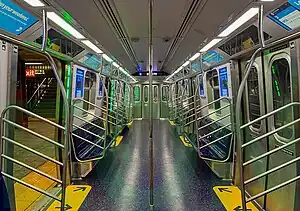 The interior of an R211A car | |
| In service | 2023–present |
| Manufacturer | Kawasaki Railcar Manufacturing |
| Built at |
|
| Family name | NTT (New Technology Train) |
| Replaced | All SIR R44s All R46s |
| Constructed | 2021–present |
| Entered service | |
| Number under construction | 1,005 (1,442 with all options exercised) |
| Number built |
|
| Number in service | 80 |
| Formation | Five-car sets (and four-car sets if second option exercised) |
| Fleet numbers | |
| Capacity | 30 seats, 210 standing per car |
| Operators | |
| Depots | Pitkin Yard[7] |
| Service(s) assigned | |
The R211 is a new technology train (NTT) New York City Subway car being built by Kawasaki Railcar Manufacturing for the B Division and the Staten Island Railway (SIR). They will replace two aging subway car models: all R44 cars on the Staten Island Railway and all R46 subway cars. The order is split into three parts: R211A and R211T cars for the subway and R211S cars for the SIR. The R211Ts employ open gangways between cars, a feature not present on current rolling stock. The base order consists of 535 cars, with options for up to 1,077 additional cars.
Planning for the R211 order started in 2011. The design process started in 2012, at which time the order was supposed to consist of 75-foot-long (23 m) cars. The cars' lengths were changed to 60 feet (18 m) by 2015, and the first request for proposals was solicited in July 2016. After several changes to the proposal, the Metropolitan Transportation Authority (MTA) awarded a contract to Kawasaki in January 2018. Delivery of the pilot cars began at the end of June 2021. They contain new features such as wider doors, information displays, LED-lit doorways, open gangways, and LED interior lighting. The R211As entered service on March 10, 2023, beginning a 30-day acceptance test. Following a successful second revenue service test with the pilot set, it officially entered service with the first production set on June 29, 2023.
Component orders
With all options exercised, the Metropolitan Transportation Authority (MTA) plans to spend $3.686 billion in the order.[8] The contract is split into three parts: R211A, R211S, and R211T. The majority of the 535-car base order will comprise 440 R211A cars that will partially replace the aging 748-car R46 fleet.[lower-alpha 1] There are also 20 R211T open gangway prototype cars, first delivered in late 2022, and 75 R211S cars that will replace the now 52 year old remaining 61-car R44 fleet on the Staten Island Railway.[8][9]: 73 The R44s and R46s are 75 feet (23 m) long, and the R211s are only 60 feet (18 m). As a result, the 752 R46s[lower-alpha 1] would need to be replaced by 940 R211s.[lower-alpha 2]
There will be two options for additional cars: the first for 640 R211A cars and the second for 437 R211A or R211T cars.[12] Option 2 is designed to accommodate either standard cars or open gangway cars, depending on the test results from the 20 R211T cars from the base order. If all options are exercised, the order would total 1,612 cars.[8] Any additional cars that do not replace existing rolling stock will be used to expand the system's fleet.[13][14]
The R211 order would provide 1,015 new cars to replace the existing fleet, as well as up to 597 cars for fleet expansions following the extension of the Second Avenue Subway and the automation of the New York City Subway.[9]: 72 The R211Ts would also increase capacity and allow passengers to walk seamlessly from one car to the next.[13][15][16][17]
Features
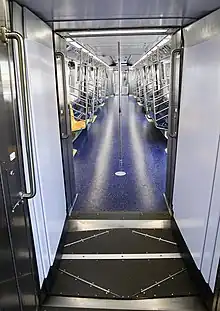
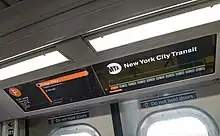
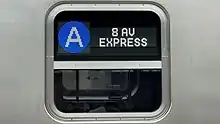
The doors on the R211s are 58 inches (150 cm) wide, compared to current MTA standard of 50 inches (130 cm),[18][1] thereby projected to reduce station dwell time by 25 to 30 percent.[19][20] This door width will also promote accessibility on the cars, making them the first fully accessible subway car in New York City.[21] This design change partially incorporates a design feature of the R110A prototype subway cars, which had doors that are 63 inches (160 cm) wide.[22]
The new cars have digital advertisements, digital customer information displays, illuminated door opening alerts, and security cameras,[23][24][1][25] unlike the current New Technology Trains, which lack these features.[26] Each car contains an on-board computer system that could detect breakdowns in critical systems such as braking and door-opening.[1]
It was announced in July 2016 that some of the cars would have open gangways, allowing passengers to move between cars during train movement.[1] The prototype cars contain two designs; the first ten cars utilize interior panels in the gangway connection, and the other ten use interior bellows in the gangway connection. The latter design also contains a wider walkway and handles between cars. To test out the curve radius and gangway flex in the existing 60-foot-long cars, an R143 test train was equipped with measuring gauges and was operated on most parts of the B Division.[lower-alpha 3]
Compared to previous New Tech train orders, the R211s have seen vast changes. On the exterior, the cars have a blue front with large windows, LED headlights, and a blue stripe with gold accents on the sides, similar to the new MTA Regional Bus Operations livery released in 2016. To designate the route, a large LED screen with the route bullet is displayed at the ends of the train, similar to the rollsigns on older trains (R40 to R68A). The route's destination is displayed above the door on the front, similar to the overhead rollsign arrangement last used on the R38 cars from 1966, which displayed both the route and destination. On the sides, there is a screen that displays both the route bullet and the route's destination, also similar to rollsign-equipped trains.
There are also several changes in interior appearance. Updated digital displays are installed over doors. The seating on the inside is blue and gold, and flip seats are installed to allow for space for wheelchairs.[23][24] There are also looped stanchions, a feature found in some R46, R62A, and R160 cars, as well as on all R179 cars. As part of an action plan to fix the subway's state of emergency of 2017, many of the R211's features were implemented on several R160s assigned to the E, F, and L trains.[27][28][29]
In addition to various screens throughout the train, touch screen displays are present throughout the subway cars, allowing people to zoom in and out of the map.[30][31] Most of the screens also display additional information, such as specific bus transfers, elevator locations, and which car the customer is located in. This feature was not shown to be operational during the first few days of passenger service, but may become operational in the near future.
All R211A and R211T cars are equipped for communications-based train control (CBTC)[12][20] in conjunction with the ongoing automation of B Division lines.[5]: 14 All R211S cars are equipped with cab signaling.[12]
History
Initial request for proposals
The R211 Design Master Plan was approved by the MTA in December 2011, and design planning began in December 2012.[15][32] An R211 solicitation was posted in the classified section of Metro Magazine's May 9, 2013, issue, stating the proposal to acquire these cars in the near future. At the time, the order was planned to be 75 feet (23 m) in length, the same length as the R46 and R68 cars. Open-gangways, which would allow passengers to seamlessly walk throughout the train or units, and other alternate configurations were also initially considered for the entire order.[33]
By the release of the MTA's 2015-2019 Capital Program in October 2015, the order specified 60-foot (18 m) cars, which has been the standard length of new B Division cars since the R143 order. As of March 2016, open-gangways will be tested on ten cars (now designated as the R211T).[16] Additionally, the order was broken up into a base order of 565 R211A cars and two option orders: the first for 375 R211A cars, and a second for up to 520 R211As.[16][13][14][33]
The Request for Proposal (RFP) was issued on July 22, 2016, and the contract was to be put out for bidding.[15][16][23] With the RFP, the breakup of the order was changed. The base order consisted of 285 cars, with 10 R211T cars, 75 R211S cars, and 200 R211A cars. There were still two option orders; the first option order contained 740 cars (either R211As or R211Ts, depending on the success of the R211Ts in the base order), and the second base order contained 520 cars. The RFP closed in December 2016,[34] and the contract was expected to be awarded in early 2017,[15] at which time the existing R46 fleet would be 42 years old, making the oldest cars 49 years old, in 2024. However, in January 2017, the contract was pushed back to mid-2017.[34]
On April 24, 2017, at the New York City Transit Board Meeting, the breakdown of the order was changed once again. The base order now includes 535 cars (an increase of 250 cars), with 10 R211T cars, 75 R211S cars, and 450 R211A cars. The option order now consisted of between 490 and 640 R211T cars. This change was made to allow for faster deliveries of the R211 cars. The R211As, with their standard configuration, would be delivered in 2021, earlier than the open-gangway R211T cars, which would not be delivered until at least 2023.[8]
Contract
Creation of mockup and contract award
.jpg.webp)

In May 2017,[34] the MTA quietly built a mockup of the R211 in a sparsely-used section of the 34th Street–Hudson Yards station's mezzanine, hidden behind a construction wall. The New York Daily News first reported on the mockup's existence in September of that year. The mockup contains features such as the open-gangway designs, digital screens showing next stops and their station layouts, multicolor lights next to the doors to indicate which set of doors will open, and a blue-and-gold-stripe paint design on its exterior.[35] The model was completed and was made publicly accessible from November 30 to December 6, 2017, so riders could review it.[36][37]
In August 2017, Bombardier Transportation, who was manufacturing the R179s at the time, was banned from bidding on the R211 contract due to various delays and problems associated with the R179 contract.[38][39] Shortly afterward, it was reported that CRRC had also opted out of contention for the R211 contract, leaving Kawasaki Heavy Industries and Alstom Transport as two of the likely bidders for the contract.[39]
On January 19, 2018, the MTA Board suggested that Kawasaki Rail Car, Inc, a subsidiary of Kawasaki Heavy Industries of Kobe, Japan, be awarded the $1.4 billion base order for the first 535 new R211 cars.[8][25] The cars were anticipated to be delivered from 2020 to 2023, with the option orders to be delivered by 2025. The R211 base order includes 20 R211T cars with open gangways; 75 R211S cars for the Staten Island Railway, to be delivered near the end of the base order; and 440 R211A cars similar to the R143/R160 series. All cars in the base order will operate in five-car units.[8][1] The first test train was then expected to be delivered in July 2020, with the production cars being delivered between 2021 and 2023.[40] The cars are being assembled at Kawasaki's factories in the U.S. at Lincoln, Nebraska, and Yonkers, New York, as well as in Japan at Kobe, Hyōgo Prefecture.[1] In October 2019, the MTA Board ratified a contract with Thales Group for the installation of CBTC equipment in 92 five-car R211 sets.[41]: 47
Option orders
In October 2018, it was confirmed that the second option order would consist of 89 sets, and in September 2019, it was confirmed that the 89 sets would be formed from 437 cars.[42][12][lower-alpha 4] The MTA also confirmed in September 2019 that the first option order would also consist of 640 cars.[43][lower-alpha 5] The entire order will consist of 1,612 cars with both options exercised.[12][44]: 12 During that time, delivery of the base order was expected to be completed by August 2023, with option 1 and option 2 completed by December 2024 and October 2025 respectively.[40]
In March 2022, the MTA Board voted to add CBTC equipment to another 128 five-car units as part of the first option order.[41]: 47 That October, the MTA Board voted to exercise the first option order for 640 cars[18][45] at a cost of US $1.7 billion.[46][47] All cars in the first option order would be R211A cars.[47][48] The cars in the option order would be delivered from February 2025 to December 2026.[47] In October 2023, the MTA Board voted on adding CBTC equipment to another 89 R211 sets as part of the second option order.[41]: 47
Delays in delivery
By January 2019, the first R211A train was scheduled to be delivered in July 2020, but was delayed to January 2021. Thereafter, new R211 cars would have been produced and delivered at a rate of 30 to 40 cars per month.[44]: 29 The first two test trains of ten R211T open-gangway cars would have been delivered in May 2021, followed by the first 5-car set of R211S cars for the Staten Island Railway in December 2021.[44]: 12 Under the schedule outlined in January 2019, the base order of R211 cars would begin delivery in October 2021[9]: 74 and continue to be delivered through mid-2023.[44]: 12 If the two option orders of 1,077 cars were exercised, deliveries would have continued through late 2025. A decision on whether to make the first option order as open-gangway or standard trainsets was needed to be decided by late 2022; by late October 2022, the first option order was confirmed to comprise standard trainsets.[44]: 13 It was also announced in January 2019 that Kawasaki had made a full-car mock-up of the R211 fleet.[44]: 15–17
In late November 2020, the MTA announced that delivery of the first cars was delayed to the first quarter of 2021.[49] The onset of the COVID-19 pandemic had impacted global supply chains and the delivery of the first cars was delayed by between 9 and 14 months.[5]: 16 By January 2021, the first cars were scheduled to arrive in April. The R211T open-gangway test trains were delayed to April 2022, while the R211S Staten Island Railway test train was delayed to August 2022. Deliveries of the base order of R211As were scheduled for September 2022 to September 2024, while deliveries of the R211S cars were scheduled for October 2023 to June 2024.[5]: 17 Kawasaki planned to deliver 22 cars per month, a rate that an independent engineering consultant for the MTA described as "aggressive".[5]: 26
In late March 2021, TV station NY1 reported that delivery of the first cars had slipped further, with the arrival of the first cars delayed to June 2021.[50] At its June 2021 meeting, the MTA's Capital Program Oversight Committee announced the R211A pilot had been delayed to July 2021 and the R211T test train had been delayed to June 2022. The production of the R211A base order, the R211S test train, and the rest of the R211S order had the same timeline as was outlined in January 2021.[51]: 12 Some of the other issues with the test train, such as cracks in the HVAC frame, had been identified in previous months and fixed.[51]: 19 The base order of R211As had to be underway by November 2023 so there would be enough cars to test a communications-based train control (CBTC) system being installed on the IND Eighth Avenue Line.[51]: 21 By July 2022, full delivery of the R211A base order and the R211S order had been delayed to 2025 due to labor issues at Kawasaki's Nebraska factory.[47][52] Kawasaki was obligated to construct 40 cars per month in Nebraska as part of its contract with the MTA.[53]
Delivery
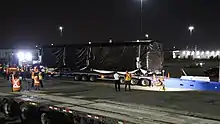
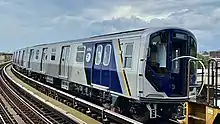
Starting on June 29, 2021,[54] the first set of R211A cars (4060–4064) was delivered to the New York City Transit Authority at the South Brooklyn Marine Terminal.[19][55] The next five cars (4065–4069) were delivered starting on July 12, 2021, forming a complete pilot ten-car train for acceptance testing and evaluation.[56] The test train was delivered despite a lack of staff in Nebraska and a shortage of important parts, which prompted an independent engineering consultant to predict that delivery of the test train could be delayed past July 2021.[51]: 21
The first of the R211T cars with the first gangway design (4040-4049) were delivered on October 31, 2022.[lower-alpha 6] By December 2022, the set began testing.[57] The first of the R211T cars with the second gangway design (4050-4059) were delivered a few months later, in January and June 2023.[lower-alpha 7]
On the first week of May 2023, the first set of R211S cars (100–104) was delivered to the South Brooklyn Marine Terminal, forming a complete pilot five-car train for acceptance testing and evaluation.[58][lower-alpha 8] After undergoing several tests on NYC Subway trackage, the unit was transported to Staten Island during the week of October 16, 2023.[60][61]
Service
The R211A cars were placed into revenue service on the A on March 10, 2023,[2][3] for a 30-day in-service acceptance test.[62][57] After successful completion, R211A cars officially entered revenue service on June 29, 2023, several months later than originally planned.[63] During a press conference at Hoyt–Schermerhorn Streets the same day, it was announced that at least two R211A trains would enter service per month.[64][65]
During a media preview of the R211T cars in February 2023 at Coney Island Yard, it was announced that the R211T cars were expected to enter revenue service in late 2023.[66][67] This was further confirmed during another press conference in late June 2023, during which it was also announced that the R211S cars would enter service in January 2024.[63] However, in a press conference made in mid-October 2023 about the R211S, it was announced that the R211S 30-day revenue entry has been delayed until March 2024.[68]
In late October 2023, all but one set of active R211A cars were temporarily pulled from service.[69][70] A video had circulated online showing an out of service train traveling at a very slow speed with flat wheels.[70] The MTA later confirmed that the cars were out of service due to multiple issues, including leaking gearboxes which had caused the flat wheels on the aforementioned set.[70][71] The agency began to return the trains to service within weeks, after fixes were completed.[71]
Notes and references
Notes
- 1 2 The R211 order is slated to replace 752 R46 cars.[8][9]: 73 Four of these cars were scrapped after separate incidents in 2017 and 2020, leaving only 748 cars in revenue service.[10][11]
- ↑ Both quantities represent 94 full-length trainsets, each of which is 600 ft (180 m) long. Each 600-foot trainset of R46s would require eight cars, while each 600-foot trainset of 60 long cars would require ten such cars. As such, 752 R46 cars could be arranged to make 94 full-length trainsets, and 940 sixty-foot-long cars could be arranged to make 94 such trainsets.
- ↑ See also:
- Tech And Transit (April 4, 2017), R211 Open Gangway Measurement Test Train (R143 8269-8272), archived from the original on December 15, 2021, retrieved April 5, 2017
- ↑ An option order with 333 cars would only result in 83.25 train sets of four cars, but an MTA board meeting document from October 2018 mentions 89 four- and five-car trainsets in the second option order, all of which would be equipped with communications-based train control. Assuming all 437 cars will be equipped with CBTC, the order would have to be divided into 81 five-car sets, totaling 405 cars, plus 8 four-car sets, totaling 32 cars.
- ↑ If the second option had 333 cars, there would 88 cars in 22 sets of four cars each, and 245 cars in 49 sets of five cars each.
- If the second option had 437 cars, there would be 32 cars in 8 sets of four cars each, and 405 cars in 81 sets of five cars each.
- ↑ See:
- Hammers, DJ (November 1, 2022). New Prototype R211T Open-Gangway Test Train Delivered to New York City! – via YouTube.
- ↑ See:
- Tech and Transit (February 14, 2023). New R211T Design 2 "Soft Shell" Cars 4050-4054 Being Transferred to East New York Yard. Retrieved February 19, 2023 – via YouTube.
- ↑ See also:[4][59]
References
- 1 2 3 4 5 6 7 Maslin Nir, Sarah (January 19, 2018). "New York Set to Acquire the Next Generation of Subway Cars". The New York Times. Archived from the original on January 20, 2018. Retrieved January 20, 2018.
- 1 2 Lin, Sarah Belle (March 10, 2023). "Latest subway cars roll into service, start their journey on the A line". amNewYork. Archived from the original on March 10, 2023. Retrieved March 10, 2023.
- 1 2 "New MTA subway cars roll out on the A line". Spectrum News NY1 New York City. March 10, 2023. Archived from the original on March 10, 2023. Retrieved March 10, 2023.
- 1 2 3 The Sounds & Sights in This Kawasaki Side-by-Side Factory Are Unlike Anything I've Ever Experienced!, archived from the original on January 21, 2023, retrieved January 21, 2023
- 1 2 3 4 5 "Capital Program Oversight Committee Meeting January 2021". web.mta.info. Metropolitan Transportation Authority. January 2021. Retrieved January 19, 2021.
- ↑ "Capital Program Oversight Committee Meeting June 2022". web.mta.info. Metropolitan Transportation Authority. June 27, 2022. Retrieved January 19, 2018.
- ↑ "MTA on Twitter "That moment when you're waiting for the train and ✨this✨ pulls up"". Twitter. Retrieved March 10, 2023.
- 1 2 3 4 5 6 7 "New York City Transit and Bus Committee Meeting 1/22/2018" (PDF). mta.info. Metropolitan Transportation Authority. January 22, 2018. pp. 134–136. Archived from the original (PDF) on January 27, 2018. Retrieved October 20, 2018.
- 1 2 3 4 "Capital Program Oversight Committee Meeting January 2020". web.mta.info. Metropolitan Transportation Authority. January 2020. Archived from the original on January 10, 2021. Retrieved January 19, 2018.
- ↑ "New York City Subway Car Update" (PDF). The Bulletin. Electric Railroaders' Association. 61 (2): 6–7. February 2018. Archived (PDF) from the original on June 14, 2022. Retrieved June 16, 2022.
- ↑ "New York City Subway Car Update" (PDF). The Bulletin. Electric Railroaders' Association. 63 (11): 20. November 2020. Archived (PDF) from the original on June 16, 2022. Retrieved June 16, 2022.
- 1 2 3 4 5 "New York City Transit and Bus Committee Meeting October 2018" (PDF). mta.info. Metropolitan Transportation Authority. October 19, 2018. pp. 188–189. Archived (PDF) from the original on October 12, 2021. Retrieved October 20, 2018.
- 1 2 3 "Review of the A and C Lines" (PDF). Metropolitan Transportation Authority. December 11, 2015. Archived (PDF) from the original on February 3, 2020. Retrieved January 19, 2016.
- 1 2 "MTA Twenty-Year Capital Needs Assessment 2015-2034" (PDF). Metropolitan Transportation Authority. October 2013. Archived (PDF) from the original on July 14, 2015. Retrieved August 11, 2015.
- 1 2 3 4 "MTA Capital Program Oversight Committee Meeting: January 2016" (PDF). mta.info. Metropolitan Transportation Authority. January 2016. Archived from the original (PDF) on January 29, 2016. Retrieved January 23, 2016.
- 1 2 3 4 "Transit & Bus Committee Meeting - March 2016" (PDF). Metropolitan Transportation Authority. March 21, 2016. Archived (PDF) from the original on March 27, 2016. Retrieved March 19, 2016.
- ↑ Rivoli, Dan (August 13, 2015). "Ancient subway trains on C and J/Z lines won't be replaced until 2022, documents say". Daily News (New York). Archived from the original on November 26, 2015. Retrieved November 25, 2015.
- 1 2 "New York set to order 640 new subway cars". Trains. October 25, 2022. Archived from the original on November 3, 2022. Retrieved November 3, 2022.
- 1 2 Duggan, Kevin (July 1, 2021). "MTA moves forward with new R211 train cars after yearlong delay". amNewYork. Archived from the original on July 1, 2021. Retrieved July 2, 2021.
- 1 2 "MTA unveils new fleet of subway cars". ABC7 New York. July 1, 2021. Archived from the original on July 1, 2021. Retrieved July 2, 2021.
- ↑ Preview: Our New R211 Subway Cars, archived from the original on November 19, 2022, retrieved November 19, 2022
- ↑ "R-110 New Technology Test Program". www.nycsubway.org. Archived from the original on July 9, 2016. Retrieved July 19, 2016.
- 1 2 3 "Governor Cuomo Unveils Design of Reimagined MTA Subway Cars and Details Ambitious Plan to Enhance Subway Stations". July 18, 2016. Archived from the original on August 5, 2016. Retrieved July 19, 2016.
- 1 2 "MTA renderings" (PDF). www.governor.ny.gov. July 18, 2016. Archived (PDF) from the original on September 19, 2016. Retrieved July 18, 2016.
- 1 2 "kawasakirc.com NYCT Awards R211 Contract". Kawasaki Rail Car, Inc. January 27, 2018. Archived from the original on August 4, 2018. Retrieved August 5, 2018.
- ↑ "NYC, meet your (possible) subway cars of the future". am New York. January 25, 2016. Archived from the original on November 8, 2020. Retrieved April 25, 2016.
- ↑ Chung, Jen (October 3, 2017). "Photos: Step Inside The MTA's New Subway Cars, Now With Less Seating". Gothamist. Archived from the original on October 4, 2017. Retrieved October 4, 2017.
- ↑ Furfaro, Danielle (October 3, 2017). "MTA removes seats from E train cars". New York Post. Archived from the original on October 4, 2017. Retrieved October 4, 2017.
- ↑ "news - Subway Action Plan Update: New Subway Cars on E Line". MTA. October 3, 2017. Archived from the original on June 30, 2020. Retrieved January 20, 2018.
- ↑ Miller, Seth (December 1, 2017). "Taking the new NYC Subway R211 cars for a test drive". Medium. Archived from the original on November 9, 2021. Retrieved February 23, 2021.
- ↑ "Here's Your Chance to Test 'Ride' the Next Subway Car | WNYC | New York Public Radio, Podcasts, Live Streaming Radio, News". WNYC. Archived from the original on July 31, 2021. Retrieved February 23, 2021.
- ↑ "Capital Program Oversight Committee Meeting: October 2012" (PDF). Metropolitan Transportation Authority. October 2012. Archived from the original (PDF) on November 2, 2013. Retrieved January 24, 2016.
- 1 2 "New York City Transit: R211 - New Generation of Subway Cars". Metro Magazine, MTA New York City Transit. May 2013. Archived from the original on November 26, 2015. Retrieved November 25, 2015.
- 1 2 3 "Capital Program Oversight Committee Meeting" (PDF). Metropolitan Transportation Authority. January 23, 2017. p. 37. Archived (PDF) from the original on January 23, 2017. Retrieved September 5, 2017.
- ↑ Rivoli, Dan (September 5, 2017). "New subway train prototype up but hidden at Hudson Yards station". NY Daily News. Archived from the original on September 5, 2017. Retrieved September 5, 2017.
- ↑ Rivoli, Dan (November 30, 2017). "MTA unveils models of future subway cars available for viewing". NY Daily News. Archived from the original on November 30, 2017. Retrieved December 1, 2017.
- ↑ Barone, Vin (November 30, 2017). "Tour the MTA's potential new subway cars". am New York. Archived from the original on December 1, 2017. Retrieved December 1, 2017.
- ↑ "Bombardier shut out of N.Y. subway contract because of 'poor performance'". Montreal Gazette. August 30, 2017. Archived from the original on August 30, 2017. Retrieved August 31, 2017.
- 1 2 "Kawasaki vying for $3.2 billion New York subway order". 1330 & 101.5 WHBL. Midwest Communications. August 31, 2017. Archived from the original on September 1, 2017. Retrieved September 1, 2017.
- 1 2 "Capital Program Oversight Committee Meeting January 2018" (PDF). web.mta.info. Metropolitan Transportation Authority. Archived (PDF) from the original on January 20, 2018. Retrieved January 19, 2018.
- 1 2 3 "Capital Program Oversight Committee Meeting October 2023". web.mta.info. Metropolitan Transportation Authority. October 2023. Retrieved January 19, 2018.
- ↑ "S-48013 R179/R211 Carborne Equipment for the CBTC 8th Avenue Line" (PDF). mta.info. Metropolitan Transportation Authority. December 14, 2018. Archived (PDF) from the original on January 20, 2019. Retrieved January 20, 2019.
- ↑ "MTA Capital Program 2020-2024" (PDF). mta.info. Metropolitan Transportation Authority. September 20, 2019. p. 185 (PDF p. 187). Archived (PDF) from the original on January 10, 2021. Retrieved September 23, 2019.
- 1 2 3 4 5 6 "Capital Program Oversight Committee Meeting" (PDF). Metropolitan Transportation Authority. January 2019. Archived (PDF) from the original on November 20, 2021. Retrieved January 18, 2019.
- ↑ "NYCT approves order for more R211 subway cars. For Railroad Career Professionals". Progressive Railroading. Archived from the original on November 3, 2022. Retrieved November 3, 2022.
- ↑ "川崎車両、ニューヨーク市交通局向け「R211」640両の追加受注内定" [Kawasaki Rail Car Receives Additional Order for 640 R211s from New York City Transit Authority]. MyNavi News (in Japanese). October 27, 2022. Archived from the original on October 27, 2022. Retrieved October 27, 2022.
- 1 2 3 4 Brachfeld, Ben (October 23, 2022). "MTA considering $1.78 billion additional spending to buy hundreds of brand-new subway cars". amNewYork. Archived from the original on November 3, 2022. Retrieved November 3, 2022.
- ↑ MTA Board - NYCT/Bus Committee Meeting - 10/24/2022, archived from the original on October 28, 2022, retrieved November 3, 2022
- ↑ Martinez, Jose (November 29, 2020). "Subway Slowdown: Sleek New Train Cars Running Late in Pandemic". The City. Archived from the original on November 30, 2020. Retrieved November 30, 2020.
- ↑ "Newest MTA Train Model Continues to Face Delays Amid COVID-19". www.ny1.com. Archived from the original on April 1, 2021. Retrieved April 2, 2021.
- 1 2 3 4 "Capital Program Oversight Committee Meeting". Metropolitan Transportation Authority. June 23, 2021. Archived from the original on July 25, 2021. Retrieved January 18, 2019.
- ↑ Guse, Clayton (June 27, 2022). "Labor problems at Nebraska plant where NYC subway cars built sparking delivery delays, MTA says". New York Daily News. Archived from the original on November 3, 2022. Retrieved November 3, 2022.
- ↑ "Subway car takes the win in 'Coolest Thing Made in Nebraska' contest". KMTV 3 News Now Omaha. October 11, 2022. Archived from the original on November 3, 2022. Retrieved November 3, 2022.
- ↑ "Next generation MTA subway car arrives in NYC for testing". PIX11. June 30, 2021. Archived from the original on July 2, 2021. Retrieved July 1, 2021.
- ↑ "First Kawasaki R211 Subway cars arrive in New York". Railway Gazette International. July 2, 2021. Archived from the original on July 9, 2021. Retrieved July 8, 2021.
- ↑ Second (2nd) R211 Set (R211A 4065-4069) Being Moved to Coney Island Yard - July 16, 2021, retrieved June 29, 2023
- 1 2 DeAngelis, Jenna (February 3, 2023). "MTA unveils new R211 open gangway subway trains". MTA unveils new R211 open gangway subway trains. Archived from the original on February 4, 2023. Retrieved February 4, 2023.
- ↑ Bascome, Erik (May 9, 2023). "First new Staten Island Railway cars arrive in NYC: Here's what riders can expect". silive. Retrieved October 18, 2023.
- ↑ Brand New Subway Trains for Staten Island Railway – Delivery of First R211S Cars to New York City, archived from the original on May 3, 2023, retrieved May 3, 2023
- ↑ Gonella, Catalina (October 17, 2023). "Staten Island slated to secure first new subway cars in 50 years". Gothamist. Retrieved October 18, 2023.
- ↑ Charles, Charline (October 18, 2023). "MTA unveils new subway cars on Staten Island, the first in 50 years". PIX11. Retrieved October 18, 2023.
- ↑ "NYC subway: MTA hosts 1st ride aboard brand new R211 train". ABC7 New York. February 3, 2023. Archived from the original on February 3, 2023. Retrieved February 4, 2023.
- 1 2 MTA News Conference - 6/29/2023, retrieved June 29, 2023
- ↑ Fadal, Tamsen; Chan, Shirley; Tamsen Fadal, Shirley Chan (June 30, 2023). "Additional R211 train put in service on A line in NYC". PIX11. Retrieved July 2, 2023.
- ↑ Nessen, Stephen (June 29, 2023). "MTA rolls out more modern trains on NYC subway". Gothamist. Retrieved July 2, 2023.
- ↑ "MTA provides first look at open-gangway subway cars". Trains. February 7, 2023. Archived from the original on February 14, 2023. Retrieved February 14, 2023.
- ↑ May, Tiana (February 10, 2023). "New York's MTA Unveils New R211 Subway Trains". Railway-News. Archived from the original on February 14, 2023. Retrieved February 14, 2023.
- ↑ MTA News Conference - 10/17/2023, retrieved October 20, 2023
- ↑ Euzarraga, Matthew (October 27, 2023). "New subway cars already taken out of service". PIX11. Retrieved October 27, 2023.
- 1 2 3 Nessen, Stephen (October 26, 2023). "MTA's gleaming new subway cars taken out of service for faulty gearboxes, flat wheels". Gothamist. Archived from the original on October 26, 2023. Retrieved October 27, 2023.
- 1 2 Martinez, Jose; Bhat, Suhail (November 14, 2023). "4/5/6 Beats A/C/E: Lettered Subway Lines Hit Reliability Dip". THE CITY - NYC News. Retrieved November 16, 2023.